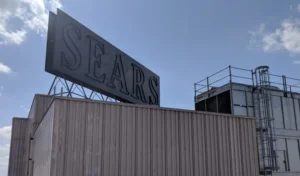9.4-acre site will house mix of commercial tech spaces, best-in-class infrastructure, entrepreneurial talent to foster innovation

HOUSTON — (April 12, 2018) — Houston Mayor Sylvester Turner and Rice University today announced plans for a new Midtown innovation district that will transform a 9.4-acre site, anchored by the former Sears building, into a hub designed to bring together the area’s entrepreneurial, corporate and academic communities into collaborative spaces and programs.
“The innovation district will leverage the region’s unique economic strengths and help transform Houston into a world leader in data science and digital technologies centered on energy, industrial, health care and logistics industries,” said Rice President David Leebron. “We aim to attract talent and support all stages of the innovation life cycle through state-of-the-art resources, incubators and accelerators, classroom and event space, technology, prototyping facilities, networking opportunities and entrepreneurship support and training.”
“Houston is always transforming,” Turner said. “We went from a cotton, rice and rail hub to the energy capital of the world, a global center for biomedical breakthroughs and an enviable model for inclusion for people and cultures from everywhere. Thanks to Rice and our many other partners in the innovation district being announced today, the city is poised to make yet another dramatic leap into the future. We are laying the groundwork to make Houston the next great center for startups and imaginative endeavors in the digital universe, and now we have a pivotal physical home for our work on the next frontier.”
The district will combine a variety of commercial uses with housing, food and entertainment, iconic public space and best-in-class infrastructure, Leebron said. “The surrounding neighborhoods’ vibrant and rich culture will be embraced to create an eclectic, engaging streetscape that blends the historic with the new and celebrates Houston’s diversity,” he said.
“This will be an innovation and incubation facility for all Houston. Rice owns the property, but the enterprise will be a collaborative mix of many different participants and activities,” Leebron said.
Leaders of many of the major educational institutions in the region, as well as corporate leaders in the health care, energy, industrial and technology industries, have indicated their desire to participate in this centrally located innovation district. The site, owned by Rice Management Co. as part of the university’s endowment, is located in close proximity to the METRORail Red Line and central to downtown, the Museum District and the Texas Medical Center (TMC), which has committed to support the project, along with the Greater Houston Partnership (GHP) and Houston Exponential (HX).
The site is at the epicenter of Houston institutions of higher education, with nearly all located within a 3-mile radius, Leebron said. He said the University of Houston, the University of Houston-Downtown, Texas Southern University, the University of St. Thomas, Houston Baptist University, South Texas College of Law Houston, Houston Community College and Lone Star College have expressed their support for the project and intention to participate. The TMC plans to put its digital initiative in the facility when it is completed.
“There’s a thriving innovation community here in Houston, but it’s spread out across the city,” said Bill McKeon, TMC president and CEO. “This site will serve as a cornerstone of the Houston innovation district, which will finally connect those hubs.”
In developing these plans, Rice worked closely with the GHP, HX and Station Houston, the region’s hub for tech innovation and entrepreneurship focused on digital technologies. Station Houston will serve as incubator and amenity program operator and will work on three key initiatives: connecting ecosystem players to drive high-impact collaborations; supporting entrepreneurs and the innovation community through a range of programs, workshops and events; and working with academic institutions and other groups to develop and connect Houston’s digital workforce.
“Transformative,” John Reale Jr., co-founder and CEO of Station Houston, said of the project. “Today we take a major step forward toward our shared vision of transforming Houston into a world-leading tech innovation and entrepreneurship ecosystem. This could not be possible without the ongoing collaboration of Houston’s academic institutions, corporations, major institutions, investors and entrepreneurs. We applaud Rice for its vision and commitment in leading this community effort.”
“The district will serve as the central anchor of Houston’s innovation corridor, a concentration of activity that has already piqued the interest of several major companies looking to build synergies with our startups and innovators,” said Bob Harvey, GHP president and CEO. “To have a physical hub for this collaboration is exactly what Houston needs and is another positive step forward for our community.”
“The formation of the innovation district is a significant milestone in the implementation of the 10-point strategic plan we announced in 2017 to build a world-class innovation ecosystem in Houston,” said HX Chairwoman Gina Luna. “This announcement builds on the momentum we’ve created over the last year, including the formation of HX and the HX Venture Fund. This is incredibly exciting for Houston.”
The former Sears building will be renovated for the project. The overall design and development of the building will be led by Hines in conjunction with architects Gensler and James Carpenter. The initial phase is expected to be completed within two years. The redevelopment of the building will respect its historic character while making the modifications required to create dynamic space for creative companies in the innovation ecosystem, Leebron said.
“The many participants already committed to this vision typify Houston’s collective spirit of inclusivity and entrepreneurship, and we welcome people and organizations who can contribute to its overarching mission,” he said.